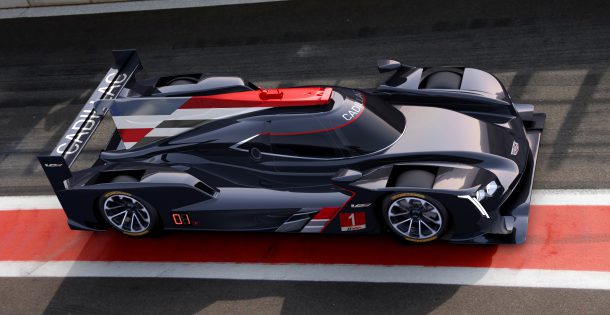14 Years Later, Cadillac Returns to the Endurance Track

Cadillac Racing has dutifully fielded entries in the Pirelli World Challenge since 2005, but the automaker’s motorsports division will now return to endurance racing after a 14-year hiatus.
The automaker revealed its 2017 Cadillac DPi-V.R, designed to hit the track in January as an entry in the 2017 IMSA WeatherTech SportsCar Championship Series Prototype (P) class. Its maiden voyage? The 24 Hours of Daytona — erm, “Rolex 24 At Daytona.”
All of this, of course, is designed to get you into a new CTS.
Powering Cadillac’s return to prototype endurance racing is an Earnhardt Childress Racing Engines naturally aspirated 6.2-liter V8. While it shares its displacement with the supercharged unit found in the CTS-V, that’s where the similarities end. Horsepower doesn’t stray too far, though — at 600 hp, it undercuts the production motor by 40 hp.
The massively modified engine sends power to the rear wheels through an X-TRAC paddle-shift sequential transmission. Taking turns behind the wheel at the season opener are teams from Wayne Taylor Racing and Action Express Racing.
In crafting the DPi-V.R, Cadillac tapped chassis builder Dallara and turned its own design and sculpting team loose on the body. (The designers made sure to keep signature styling cues visible to you, the customer.)
Yes, the automaker’s return to the series will come emblazoned with reminders that Cadillac. Builds. Some. Fast. Cars.
“Cadillac’s V-Performance production models — the ATS-V and CTS-V — are transforming our brand’s product substance, earning a place among the world’s elite high performance marques,” brand president Johan de Nysschen said in a statement. “The Cadillac DPi-V.R further strengthens our V-Performance portfolio, placing Cadillac into the highest series of sports car racing in North America.”
The Project pinnacle of racing, one might say. It’s not surprising that Cadillac wants to boost the visibility of its V cars — in fact, the brand’s motivation can clearly be seen here and here.
[Image: General Motors]

More by Steph Willems
Latest Car Reviews
Read moreLatest Product Reviews
Read moreRecent Comments
- Spectator Wild to me the US sent like $100B overseas for other peoples wars while we clammer over .1% of that money being used to promote EVs in our country.
- Spectator got a pic of that 27 inch screen? That sounds massive!
- MaintenanceCosts "And with ANY car, always budget for maintenance."The question is whether you have to budget a thousand bucks (or euro) a year, or a quarter of your income.
- FreedMike The NASCAR race was a dandy. That finish…
- EBFlex It’s ironic that the typical low IQ big government simps are all over this yet we’re completely silent when oil companies took massive losses during Covid. Funny how that’s fine but profits aren’t. These people have no idea how business works.


































Comments
Join the conversation
Both of these teams have good long history with GM prototype racing, having successfully campaigned the Corvette DP's for years now. This is essentially that car's replacement rebranded as a Cadillac. I would imagine this engine is a development of either that DP engine (which was a 6.0 L if I recall), or the 5.5L in the GTLM C7R Corvettes. This effort could've just as easily been branded a Chevrolet or Corvette like the previous prototype, but I'm guessing GM decided that with Corvette being so well established in the GT class, they would share the endurance racing glory and wealth around a bit with other brands. My guess is that it all comes out of the same GM Racing budget, so this car was always going to happen, the only question being what brand it would be. I also wonder if this was labeled a Cadillac in part because they were anticipating more premium brands to compete against. There were lots of strong rumors of Mercedes, Bentley, Lexus. and/or Audi interest in the new class but none of those efforts have panned out for now. Instead, Cadillac is facing off against Mazda and Nissan for the time being (although Nissan could always choose to rebrand as Infiniti). The Cadillac design cues are there because that's part of the design philosophy of the DPi class. Look at the Mazda car and you'll see the Kodo design language there. The ACO LMP2 class rules, which served as the starting point for this class, were designed with generic bodywork and a spec engine, so no connection to any car manufacturer. In the WEC, that's what the LMP1s are for, with LMP2 being the pro-am class. In IMSA, on the other hand, there is no LMP1, so this is the flagship prototype class with LMPC being the pro-am. In modifying the ACO class for its own series, IMSA and its participating automakers wanted freedom to design their own bodywork to help bring some visual variety to the grid, make the cars more recognizable to viewers, and give the manufacturers opportunities to experiment with the aero and other elements of the car. Some quick comparative analysis has already emerged of the Cadillac vs the Mazda, with differences in philosophy already showing. This desire for recognizable branding is nothing new in prototype racing, and it only makes sense that, when winning the Rolex 24 or 12 Hours of Sebring, you want people to recognize your car.
If you are not going to show us new technology then prototype racing is just advertising. And that may not work out as beating Porsche is unlikely.